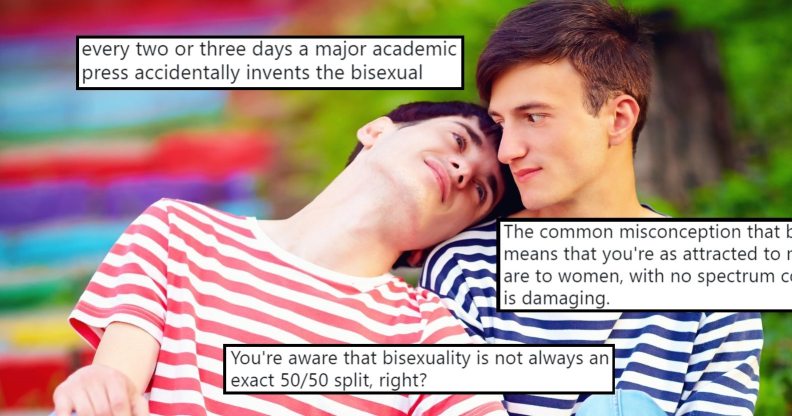People have pointed out a small flaw in this book that says ‘mostly straight’ is a sexuality

(Twitter)
A new book has strongly advocated for the concept of “mostly straight” men.
Ritch Savin-Williams, a developmental psychology professor, writes that “we hear a lot about the Big Three Sexualities – straight, bisexual and gay.
“Most of us assume that these three orientations encompass the universe of sexual identities.

“But there is a new kid on the block: the mostly straight male,” the Cornell University professor states.
Of course, since sexuality is a spectrum, there will be some people who identify nearer one end of the scale than the other.
That’s only natural.

Gay Couple Love Home Concept
Young people are certainly more open, on average, to non-heterosexual identities and sexual fluidity.
Earlier this year, a study showed that 57% of people didn’t identify with traditional definitions of heterosexuality – and that 47% preferred not to use any labels.
Research last month also revealed that a person’s sexual orientation can fluctuate and change throughout their lifetime.
And that should only be encouraged.

But many people has observed that there may be a pre-existing term for people who are attracted – to whatever degree – to more than one gender.
The label “mostly straight” is fine for individuals, but if it’s going to be used as a widespread term, it should be acknowledged that it leaves out – erases, even – a whole other identity.
Bisexuality – that is, being attracted to more than one gender – does not have to be 50-50.

(Twitter/biprideuk)
As British activist organisation The Bisexual Index puts it, “You don’t have to be equally attracted to redheads and brunettes to be attracted to both”.
“We prefer to think of bisexuality as being like the English Channel,” it explains.
“You get wet as soon as you start swimming from Dover, and can’t dry off until Calais, no matter how deep it is beneath you!”

(Getty)
Savin-Williams also writes that “a 2011-2013 US government poll found that among 18- to 24-year-old men, 6% marked their sexual attractions as ‘mostly opposite sex.’ That’s nearly one million young men.
“Yet when these men were forced to choose between straight, bisexual or gay, about three-quarters marked straight because for them bisexual, even if it is understood as ‘bisexual-leaning straight,’ is too gay to accurately describe their identity.”
People showing concern about being seen as “too gay” is, of course, homophobic in itself.

(Getty)
They should also be able to define themselves by whichever sexual identity they want.
But if people don’t define as straight, and they don’t define as gay – if they’re attracted to more than one gender, basically – then for academics to not define them as bi can be damaging.
And that’s the point a lot of people have made.

(Twitter/floofyferret)

(Twitter/bisexualindex)

(Twitter/queenoftacos)

(Twitter/meakoopa)

(Twitter/josh_scully)

(Twitter/makkuhe)

(Twitter/val_bellatrix)
A lot of people.

(Twitter)

